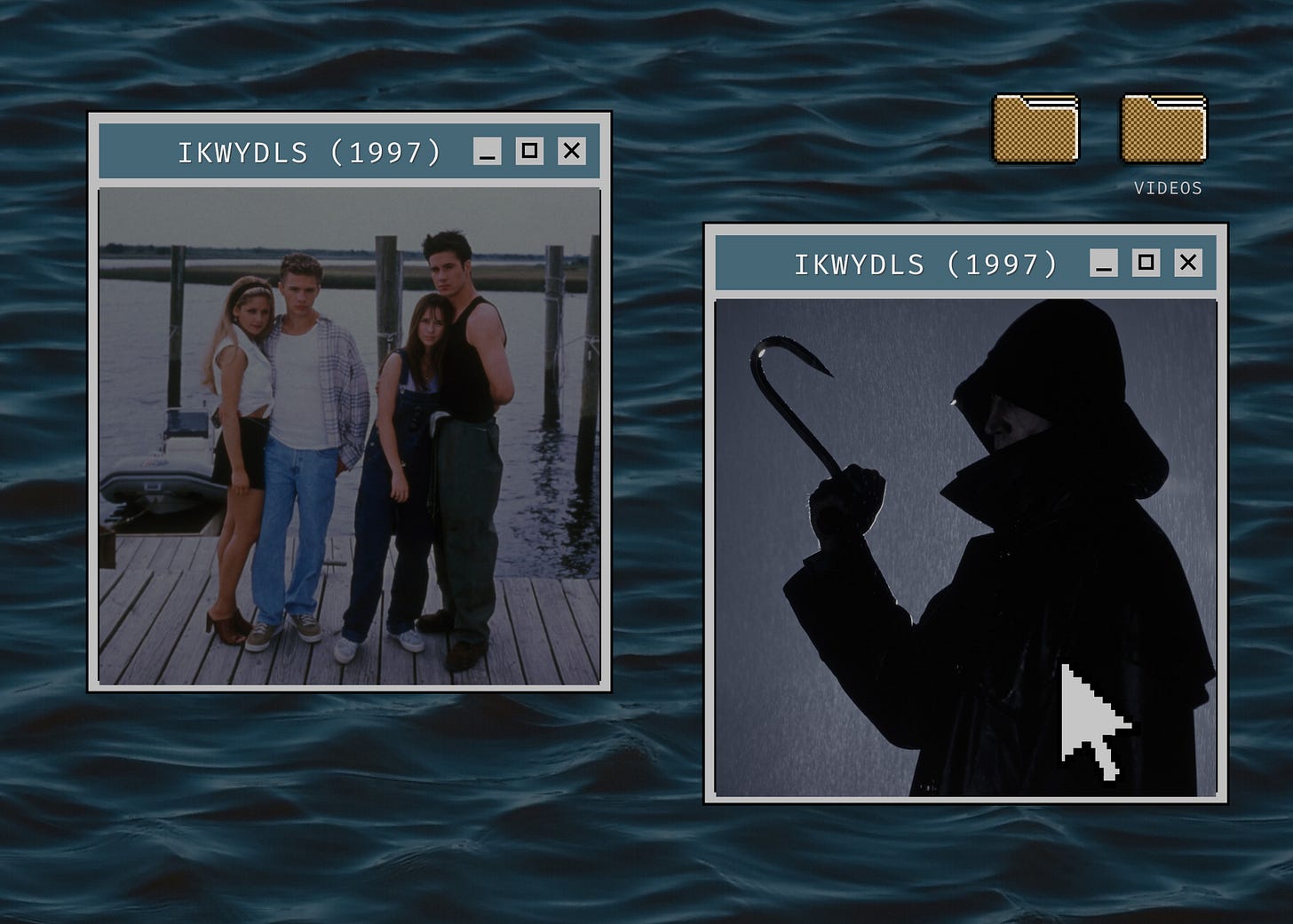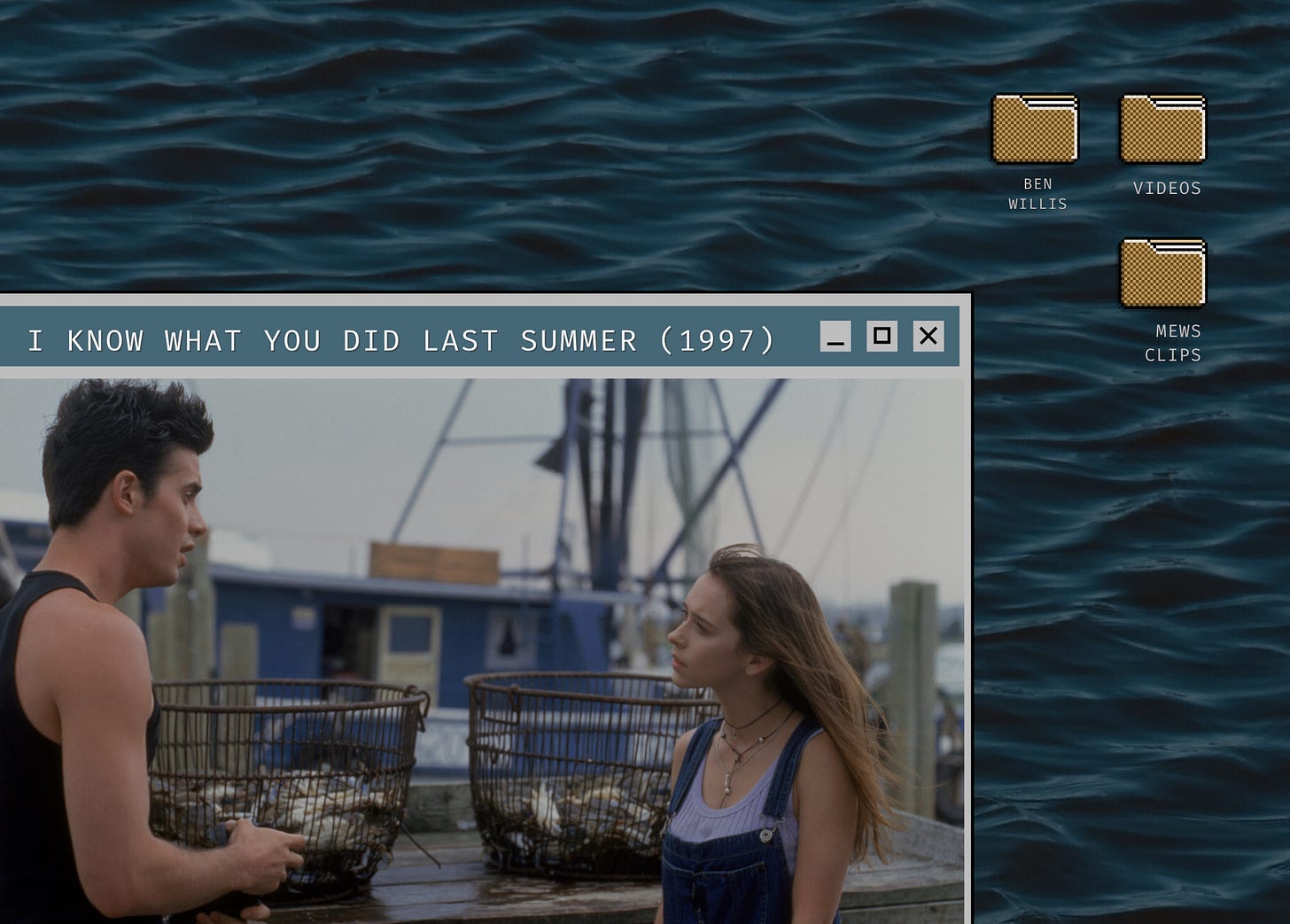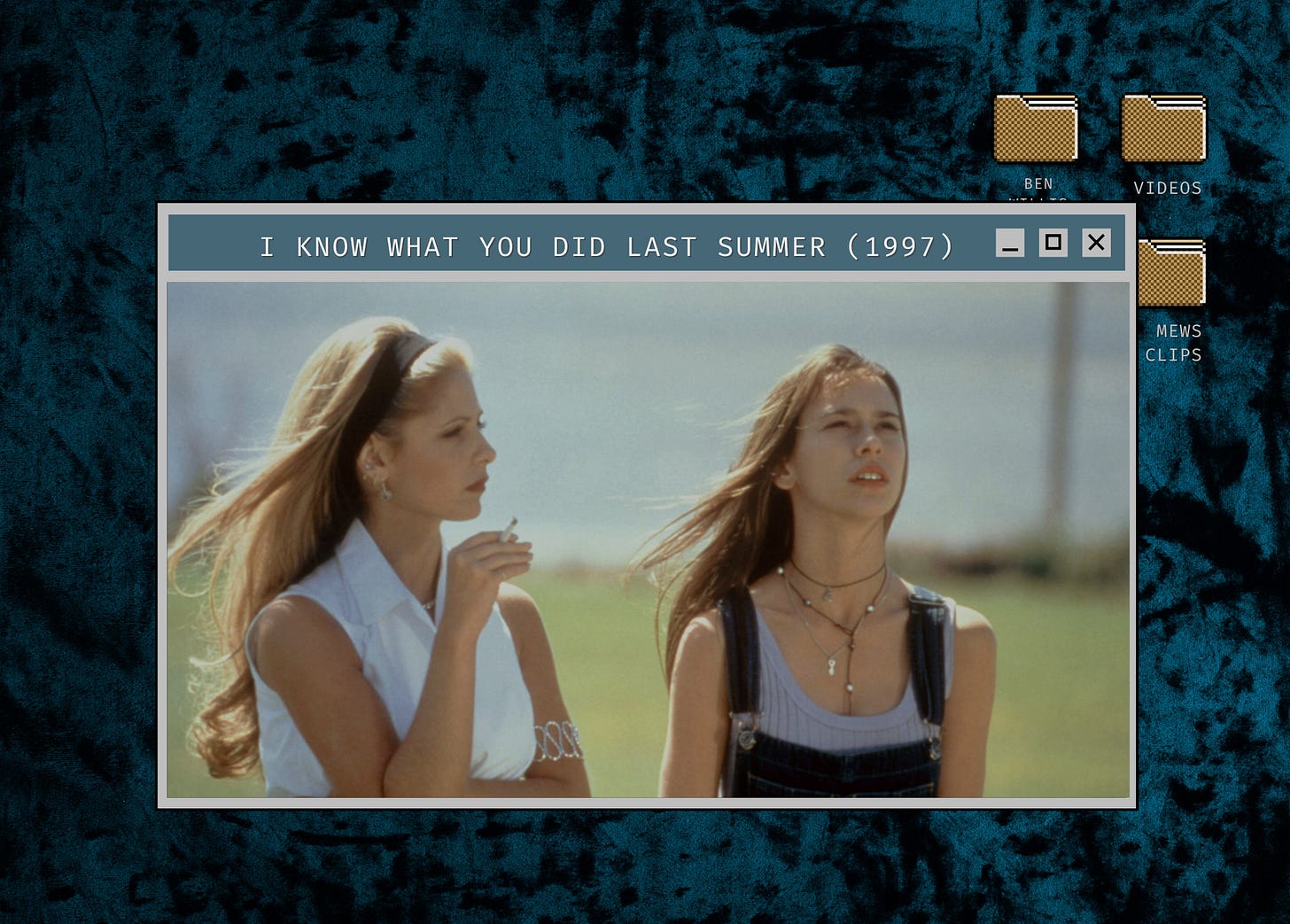GUT REACTIONS: I Know What You Did Last Summer (1997)
Especially in conversation with Scream 2 (1997), I found that the OG IKWYDLS embodies everything I love about 90s films.
In my GUT REACTIONS series, I contextualize a “first watch” with the film’s cultural significance.

Spoiled White kids, high school romance, and a painfully idyllic setting to come of age: These are the makings of a guaranteed good watch for me.
For the uninitiated: I Know What You Did Last Summer (1997) follows four friends who are involved in vehicular manslaughter on July 4, the summer before they head off to college.
I said “vehicular manslaughter” because the inciting incident is not quite a “hit and run.” In fact, what erodes the core four’s relationship is that each person has a different course of action as to how they should handle the accident.
Interestingly enough, the boy with nothing to lose and the boy with everything to lose both have the same solution for dealing with a victim on the verge of death.
Jennifer Love Hewitt plays timid-but-tenacious good girl Julie; Sarah Michelle Gellar plays tortured pageant queen Helen.
Freddie Prinze Jr. plays Ray, who is sweet on Julie and doesn’t come from money like the rest of them. From Gossip Girl and The Clique books to Camp Rock (2008), the key to rich kid media is having one character be broke — for some extra sociological razzle-dazzle.
And then there’s Barry, played by Ryan Phillippe. We need a blonde jock with classically good looks to be evil incarnate. The people who benefit from pretty privilege and grow up with everything handed to them tend to have destructive levels of self-righteousness and entitlement.
My initial reaction to IKWYDLS
My gut reaction watching IKWYDLS was, “Ah, yes, of course this hits a certain spot for me.”
Donnie Darko (2001) was everything to me in high school. Cruel Intentions (1999) — shout out Gellar and Phillippe again — shocked and delighted me equally.
I was obsessed with Heathers (1988), writing my final women’s and gender studies paper about the film.
Last year, I fell in love with The Craft (1996). This year, Blue Velvet (1986) become my comfort movie.
Based on personal experience, I love media that depicts the cognitive dissonance between pristine appearance and depraved character.
Besides, after attending a private, predominantly White, Catholic high school, I’ve seen firsthand that beneath crisply starched shirts, gleaming leather shoes, and perfectly coiffed hair hides unfathomable pain and deep-seated hatred.

What I loved about IKWYDLS
My gut reaction was that it was a fun film in the style of many 90s slashers, and couched in the tropes and style choices of teen flicks at the time.
I can see how it set the foundation for the TV show Outer Banks, a teen drama set in the murky, treacherous waters of North Carolina as well. And my other gut reaction is that 1997 was a goated year for horror movies — and for Gellar specifically.
There’s plenty of stormy scene-setting in IKWYDLS, punctuating the scenes where blisteringly bright sun illuminates pastel costumes, pale skin and even paler houses and storefronts.
Having read more than a few horror scripts during my research trip to the University of Pittsburgh’s archive collections, it’s been ingrained in me how important it is that horror screenwriters set the tone with a dark, rainy night — only to provide a stark contrast with quaint, airy daytime surroundings the next day.
I noticed this especially when I read one of the original copies of the screenplay for The Amityville Horror (1979) and Lost Boys (1987); that kind of visual whiplash is disconcerting and effective. I think David Lynch also employs this technique well in Blue Velvet.
The release of IKWYDLS is poignant, because visually, it’s in conversation with a lot of films bookending the 90s. For example, its gorgeously-shot night-time beach scene feels reminiscent of the seaside rituals that take place in The Craft. (Arguably, IKWYDLS is also building on the visual legacy of Lost Boys, where the wild and untameable ocean almost feels like a character in the film.)
And if we’re talking about release timing, the 90s fashion on display in IKWYDLS needs to be addressed.
Just like with the girls from The Craft, Julie, Helen, Ray and Barry each have distinct styles of dress and grooming that communicate volumes about their characters’ approach to life. Even the changes from the summer before college to the summer after freshman year tell you everything you need to know about how the road death did or didn’t affect them.
I think concerns about highlights, eyeliner and jewelry indicate the core of what IKWYDLS is: A teen movie that happens to be a 90s slasher.

Sure, it has the “thoughtful” guttings, which I find to be a hallmark of films such as Candyman (1992) and Scream (1996). With their victim choices, the killers have something to say.
But the kitten heels, blowouts and chokers remind you that this is Clueless (1996), just with more stitches and bloated corpses.
1997: A goated year for horror
I felt in my spirit that IKWYDLS wasn’t alone in making its mark on 1997. Fact-check: I was correct. Scream 2 also came out that year and did numbers.
And twist my arm! I rewatched Scream 2 as a part of my writing process for this post.
Even more so from the couple of times I watched previously, I found very “young” concerns to be front and center in Scream 2: Navigating your first grown-up relationship, sticking out your major, being respected in your immediate social circle, how Greek life complicates that, and so on.
The symbolism of Neve Campbell’s character, Sidney Prescott, being tossed about by a mask Greek chorus while playing Cassandra, a central psychic figure in the mythology, is heavy-handed — but it’s also so good. Even outside of the Woodsboro murder circus, it’s such a solid allegory for finding your way in the world as a woman, when your spot-on intuition is reduced to claims of hysteria.
I know it’s a cinematic device to build tension, but I absolutely hate when the horror protagonist isn’t believed by police or their peers in a slasher. It’s what gets me punching the air and kicking my feet.
Naturally, I think there’s a lot to be said here about final girls being at the heart of both of these films — a lot of horror films — and the way their struggles mirror that of everyday women. It’s a funhouse mirror, for the most part, but a mirror all the same.
I was also struck by a lot of little similarities in this film that are way less deep: An affinity for contrasting the dark and sultry alternative character with the characters dressed in pre-coquette era coquette attire.
Sarah Michelle Gellar collected a check from both projects. Buffy the Vampire Slayer also first aired in 1997, so clock that tea.
There’s also a devastating moment in both Scream 2 and IKWYDLS where someone is stuck in the back of a police car as the main killer approaches. Again: You will find yourself screaming, crying and throwing up.
As I did with Scream 2, I came away from IKWYDLS deeply satisfied. Just like with the Scream franchises, I found myself looking forward to what comes next in the IKWYDLS universe.
Watching this particular Scream installment, I was struck by the scene in Randy’s film theory class where they discuss the murders happening near the college campus.
The idea of a copycat killer making a real-life sequel to the murders, egged on by the very meta Stab movies, gets the class riled up about horror franchise sequels.
“Sequels suck,” declares Randy, reprised by Jamie Kennedy, to much groaning and monaing.
“Come on,” pushes Mickey, played by Timothy Olyphant.
“By definintion alone, they’re inferior films,” Randy continues.
“It’s a bullshit generatlization,” Mickey says. “Many sequels have far surpassed their original.”
Now, in retrospect, Mickey had reason to push this take; he was on the front lines of his own PR as the copycat killer. Ironically, Scream 2 was also critically acclaimed, beating the curse of the “sophomore slump.”
But I have hope in that Ghostface’s premise, because I watched IKWYDLS and its follow-up installment, I Still Know What You Did Last Summer (1998),in anticipation of the 2025 release.

I’m excited to get to the theater this weekend, to see if I Know What You Did Last Summer (2025) can surpass the original.









